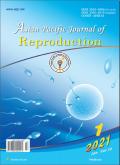Effect of taxifolin on cold-shock damages in spermatozoa in rabbits
IF 0.6
Q4 REPRODUCTIVE BIOLOGY
引用次数: 0
Abstract
Objective: To investigate the effect of taxifolin added to rabbit semen on freezing-induced cold-shock damages in spermatozoa. Methods: Semen was collected from six adult New Zealand rabbits once a week by artificial vagina. The collected semen was pooled at 38 °C and divided into four equal volumes. They were diluted with 0, 50, 100 and 200 μM taxifolin-containing Tris + egg yolk extender at 38 °C and their temperatures were lowered to 4 °C. Following equilibration, semen drawn into 0.25 mL straws were frozen in an automatic semen freezing device and stored in liquid nitrogen container at -196 °C. Samples were thawed in 38 °C water for 25 s and the analyses of motility, kinematic parameters, morphological deformities, changes in membrane integrity, mitochondrial membrane potential, dead-live ratio, acrosomal damages and as well as oxidative stress analyses were performed in semen. Results: Addition of 50 μM taxifolin significantly improved motility (total, progressive, rapid and static), high mitochondrial membrane potential and the ratios of spermatozoa with acrosomal damage compared to the control group. Compared to the control group, malondialdehyde (MDA) levels in the 50 and 100 μM taxifolin groups were significantly lower, while the MDA level was high and viable spermatozoa ratio was low in the 200 μM taxifolin group. There were no significant differences between the groups in terms of kinematic parameters, morphological deformities, membrane integrity and antioxidant levels. Conclusions: The low dose of taxifolin (50 μM) has a positive effect and the high dose (200 μM) has a negative effect. Therefore, it is concluded that the addition of low-dose (50 μM) taxifolin to the extenders would be a useful additive in reducing cold-shock damage that occurs during freezing of rabbit semen.紫杉醇对兔精子冷休克损伤的影响
目的:探讨兔精液中添加杉藻素对冷冻致精子冷休克损伤的影响。方法:采用人工阴道采集成年新西兰兔6只,每周1次。收集的精液在38°C下存放,分成四等份。分别用0、50、100、200 μM含taxifolin的Tris +蛋黄扩展剂在38℃下稀释,温度降至4℃。平衡后,抽取0.25 mL吸管的精液在精液自动冷冻装置中冷冻,并在-196°C的液氮容器中保存。样品在38°C水中解冻25 s,分析精液的运动性、运动学参数、形态畸形、膜完整性变化、线粒体膜电位、死活比、顶体损伤和氧化应激分析。结果:与对照组相比,添加50 μM紫杉醇可显著改善精子的运动能力(总、渐进、快速和静态),提高线粒体膜电位和顶体损伤的精子比例。与对照组相比,50和100 μM taxifolin组丙二醛(MDA)水平显著降低,而200 μM taxifolin组丙二醛(MDA)水平较高且活精子率较低。各组之间在运动参数、形态变形、膜完整性和抗氧化水平方面无显著差异。结论:低剂量(50 μM)杉木素有积极作用,高剂量(200 μM)有消极作用。因此,在扩增剂中添加低剂量(50 μM)的杉木素可有效降低兔精液冷冻过程中的冷休克损伤。
本文章由计算机程序翻译,如有差异,请以英文原文为准。
求助全文
约1分钟内获得全文
求助全文
来源期刊

Asian Pacific Journal of Reproduction
Veterinary-Veterinary (all)
CiteScore
1.70
自引率
0.00%
发文量
588
审稿时长
9 weeks
期刊介绍:
The journal will cover technical and clinical studies related to health, ethical and social issues in field of Gynecology and Obstetrics. Articles with clinical interest and implications will be given preference.
 求助内容:
求助内容: 应助结果提醒方式:
应助结果提醒方式:


